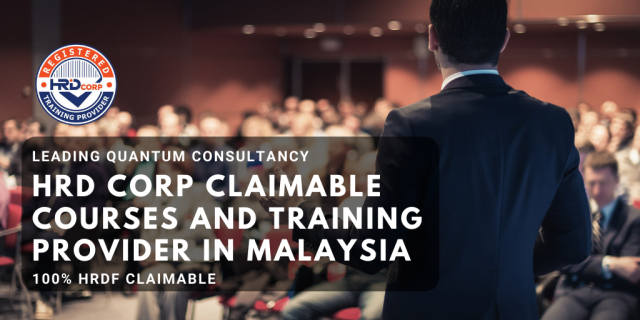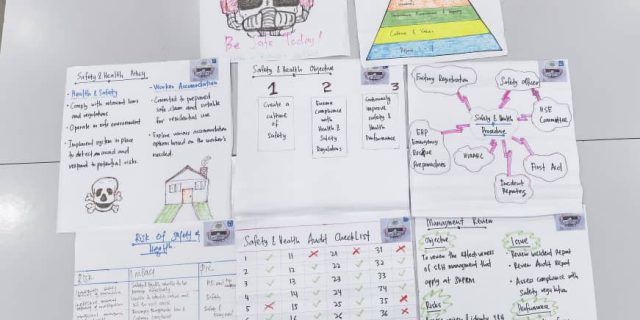Introduction
In industries where heavy lifting and material handling are routine, the safety of operations hinges significantly on the expertise of forklift operators. Mishandling forklifts can lead to severe accidents, resulting in injuries, property damage, and operational downtime. Basic Forklift Safety Training is essential for all forklift operators to ensure they possess the knowledge and skills to operate these machines safely and efficiently.
At Leading Quantum Consultancy Sdn. Bhd., we offer a comprehensive one-day training program designed to enhance the safety and operational efficiency of forklift operators. Our program minimizes the risk of injuries and property damage by equipping operators with practical skills and a deep understanding of forklift safety protocols.
Who Should Attend
This training is ideal for:
• All Forklift Operators: Regardless of experience level, operators involved in daily forklift operations.
• Warehouse Staff: Personnel who assist with loading and unloading materials.
• Supervisors and Team Leaders: Those overseeing forklift operations.
• Safety Officers: Professionals responsible for workplace safety protocols.
Learning Objectives
By participating in our Basic Forklift Safety Training, you will:
• Understand Forklift Components and Functions: Gain comprehensive knowledge of how forklifts operate and familiarize yourself with individual components.
• Comprehend Safety and Health Aspects: Learn essential safety measures to prevent accidents and ensure the well-being of all workers.
• Identify Accident Causes: Increase awareness of common causes of forklift accidents and learn proactive methods to prevent them.
• Conduct Daily Inspections: Master the procedures for thorough daily inspections to minimize breakdowns and reduce maintenance costs.
• Assess Hazards and Risks: Develop skills to identify potential hazards related to forklift operations and take appropriate actions to safeguard workers, property, and the environment.
Course Content
Our training program is meticulously structured into five comprehensive modules, each designed to enhance both theoretical understanding and practical application.
Module 1: Fundamentals of Forklift Safety (OSHA)
1. Employer and Employee Responsibilities
• Understanding Legal Obligations: Learn about the Occupational Safety and Health Act (OSHA) regulations governing forklift operations.
• Employer Duties: Explore the responsibilities of employers to provide proper training, safe equipment, and a hazard-free workplace.
• Employee Duties: Understand the operator’s role in following safety protocols, reporting hazards, and maintaining a safe work environment.
• Safety Policies and Procedures: Review company-specific safety policies and how they align with OSHA standards.
2. Regulatory Compliance (OSHA Standards)
• Certification Requirements: Learn about the necessity of operator certification and the process to obtain it.
• Safety Standards: Familiarize yourself with OSHA safety standards specific to forklift operations.
• Record Keeping: Understand the importance of maintaining accurate records of training and equipment maintenance.
3. Creating a Safe Operating Environment
• Workplace Assessments: Conduct assessments to identify potential hazards in the operating area.
• Traffic Management: Learn strategies to manage pedestrian and vehicle traffic to prevent collisions.
• Signage and Markings: Implement proper signage and floor markings to guide safe forklift operations.
4. Fostering a Safety-First Culture
• Safety Communication: Promote open communication about safety concerns without fear of reprisal.
• Continuous Training: Emphasize the importance of ongoing education and refreshers on safety practices.
• Incident Reporting: Encourage prompt reporting and analysis of near-misses and incidents to prevent future occurrences.
Module 2: Forklift Inspection
1. Pre-Operational Checklists
• Daily Inspection Routines: Learn to perform systematic checks before each shift.
• Checklist Components: Understand the critical items to inspect, including brakes, steering, controls, and safety devices.
• Documentation: Keep accurate records of inspections and report any issues immediately.
2. Component Inspection
• Engine and Transmission: Identify signs of wear or damage in mechanical components.
• Hydraulic Systems: Check for leaks, hose integrity, and proper fluid levels.
• Electrical Systems: Inspect batteries, connectors, and warning lights for functionality.
3. Safety Features Functionality
• Operational Controls: Test levers, pedals, and switches to ensure responsive control.
• Warning Devices: Verify the operation of horns, backup alarms, and lights.
• Safety Equipment: Ensure seat belts, overhead guards, and fire extinguishers are in place and functional.
4. Reporting and Documentation
• Defect Reporting Procedures: Learn the proper channels for reporting equipment issues.
• Maintenance Coordination: Understand how to coordinate with maintenance teams for repairs.
• Regulatory Compliance: Maintain documentation as required by OSHA and company policies.
Module 3: Material Handling and Storage
1. Safe Lifting Techniques
• Load Assessment: Evaluate load weight, size, and stability before lifting.
• Center of Gravity: Understand how to maintain the forklift’s stability by keeping the center of gravity within safe limits.
• Proper Fork Positioning: Learn correct fork placement and adjustment for various load types.
2. Manual Handling Methods
• Ergonomic Practices: Adopt safe body mechanics to prevent personal injury during manual handling.
• Team Lifting: Know when and how to engage additional personnel for heavy or awkward loads.
• Use of Accessories: Utilize attachments and equipment designed to assist in manual handling tasks.
3. Storage Practices
• Stacking and Unstacking: Learn safe methods for stacking materials to prevent collapse.
• Storage Area Organization: Maintain orderly storage areas to facilitate safe and efficient operations.
• Handling Hazardous Materials: Follow specific protocols for storing and handling materials that pose additional risks.
4. Handling Hazardous Materials
• Identification of Hazards: Recognize labels and symbols indicating hazardous materials.
• Protective Equipment: Use appropriate personal protective equipment (PPE) when handling dangerous substances.
• Emergency Procedures: Understand spill response and emergency protocols related to hazardous materials.
Module 4: Video Presentation
1. Visualizing Safe Operations
• Best Practices in Action: View demonstrations of correct forklift operation techniques.
• Operator Mistakes: Analyze common operator errors and how to avoid them.
• Real-Life Scenarios: Watch footage of actual workplace situations to contextualize learning.
2. Accident Scenarios and Prevention
• Case Studies: Examine detailed accounts of forklift accidents to understand root causes.
• Preventative Measures: Identify key actions that could have prevented incidents.
• Lessons Learned: Discuss takeaways and how to apply them in your workplace.
3. Best Practices in Forklift Operations
• Efficiency Techniques: Learn methods to improve operational efficiency without compromising safety.
• Environmental Awareness: Adapt operations based on different environments, such as indoor vs. outdoor settings.
• Maintenance Tips: Understand simple maintenance practices to prolong equipment life.
4. Interactive Discussion
• Knowledge Sharing: Engage with fellow participants to share experiences and insights.
• Q&A Session: Clarify doubts and deepen understanding through instructor-led discussions.
• Application Strategies: Develop ideas on how to implement best practices in your specific work context.
Module 5: Practical Session
1. Hands-On Forklift Operation
• Supervised Practice: Operate a forklift under the guidance of experienced instructors.
• Skill Development: Focus on steering, maneuvering, and controlling the forklift in various scenarios.
• Load Handling Exercises: Practice picking up, transporting, and setting down loads safely.
2. Demonstrating Daily Inspections
• Live Demonstration: Participate in a walkthrough of a complete pre-operational inspection.
• Checklists in Action: Use actual checklists to identify potential issues on a forklift.
• Problem-Solving: Learn how to address common problems found during inspections.
3. Safe Handling Techniques Practice
• Load Balancing: Experiment with different load shapes and weights to understand balance.
• Obstacle Navigation: Maneuver through a course designed to simulate workplace obstacles.
• Emergency Response: Practice procedures for situations like load instability or equipment malfunction.
4. Performance Feedback
• Individual Assessment: Receive personalized feedback on your operational techniques.
• Strengths and Areas for Improvement: Identify what you’re doing well and where you can improve.
• Action Plan Development: Create a plan to continue improving your forklift operation skills post-training.
Benefits of the Training for Staff
Enhanced Safety Awareness
• Accident Prevention: Reduce the likelihood of workplace accidents through increased knowledge and vigilance.
• Regulatory Compliance: Ensure operations meet OSHA standards, avoiding legal penalties.
• Health and Well-being: Protect yourself and colleagues from injury by following best practices.
Increased Operational Efficiency
• Reduced Downtime: Minimize equipment failures and delays caused by improper use.
• Improved Productivity: Operate forklifts more effectively to enhance workflow.
• Cost Savings: Lower maintenance costs through proper handling and routine inspections.
Professional Development
• Skill Enhancement: Upgrade your competencies as a forklift operator.
• Certification: Receive a certificate acknowledging your training, which can enhance career opportunities.
• Confidence Building: Gain confidence in your ability to perform tasks safely and efficiently.
Positive Workplace Culture
• Safety Culture Promotion: Contribute to a work environment where safety is prioritized.
• Team Collaboration: Work more effectively with colleagues through shared safety practices.
• Employee Morale: Increase job satisfaction by reducing workplace hazards.
Teaching Methodology
Our training employs a mix of theory and practical learning approaches:
• Theory Sessions: Engaging presentations featuring real-life photos, video clips, and multimedia materials to illustrate key concepts.
• Practical Sessions: Hands-on practice with forklifts to apply learned skills under expert supervision.
• Interactive Discussions: Encourage participant engagement and knowledge sharing.
• Visual Aids: Use of videos and demonstrations to reinforce learning.
Course Duration and Format
One-Day Intensive Training
Our Basic Forklift Safety Training is a focused program conducted over one day, from 9:00 AM to 5:00 PM, designed to deliver comprehensive knowledge and practical skills.
Workshop Schedule:
- 9:00 AM – 10:30 AM: Module 1 – Fundamentals of Forklift Safety
- 10:30 AM – 10:45 AM: Morning Break
- 10:45 AM – 12:30 PM: Module 2 – Forklift Inspection
- 12:30 PM – 1:30 PM: Lunch Break
- 1:30 PM – 3:00 PM: Module 3 – Material Handling and Storage
- 3:00 PM – 3:15 PM: Afternoon Break
- 3:15 PM – 4:00 PM: Module 4 – Video Presentation
- 4:00 PM – 5:00 PM: Module 5 – Practical Session
Certification
Participants will receive a certificate upon completion, recognizing their commitment to safety and enhanced forklift operation skills.
Why Choose This Course?
Benefits for Your Organization
• Improved Safety Record: Reduce workplace accidents and associated costs.
• Compliance Assurance: Meet legal obligations under OSHA and local regulations.
• Enhanced Productivity: Skilled operators contribute to smoother operations and efficiency.
Real-World Application
• Expert Trainers: Learn from seasoned professionals with extensive industry experience.
• Customized Content: Training tailored to address the specific challenges of your industry.
• Immediate Impact: Apply new skills directly to your daily operations for instant benefits.
HRDF Claimable Training with Leading Quantum Consultancy
About HRDF
The Human Resources Development Fund (HRDF) in Malaysia supports employers in developing their workforce. Companies registered with HRDF can claim the cost of training programs, making it more feasible to invest in employee development.
Why Utilize HRDF Funds?
• Cost-Effective Training: Maximize your training budget through HRDF claims.
• Workforce Development: Invest in your operators without financial strain.
• Competitive Advantage: Maintain a skilled workforce to stay ahead in your industry.
Why Choose Leading Quantum Consultancy Sdn. Bhd.?
• Proven Expertise: Our team consists of subject matter experts with a track record of success.
• 100% Success Rate: Clients consistently achieve their training and development goals with us.
• Comprehensive Services: Beyond training, we offer consultancy, advisory, and auditing services to support your organizational needs.
Registration Information
How to Enrol
Join our upcoming training sessions available in major locations like Kuala Lumpur and Penang. To register:
• Contact Person: Maheran Hassan
• Phone: 014-611 5723
• Email: yanmaheran.lq@gmail.com
Course Fees and HRDF Claimability
• Course Fees: Contact us for a customized quote based on your organization’s requirements.
• HRDF Claimable: Our training program is fully HRDF claimable, maximizing your investment in safety and operational efficiency.
Conclusion
Investing in Basic Forklift Safety Training is a critical step toward ensuring a safe and efficient workplace. By empowering your forklift operators with the necessary knowledge and skills, you not only comply with regulatory standards but also enhance productivity and protect your most valuable assets—your employees.
Take Action Towards a Safer Workplace
Equip your team with the expertise to operate forklifts safely and confidently. Let Leading Quantum Consultancy Sdn. Bhd. be your partner in promoting safety and operational excellence.
Contact Us Today
• Maheran Hassan
• Phone: 014-611 5723
• Email: yanmaheran.lq@gmail.com
At Leading Quantum Consultancy Sdn. Bhd., we’re committed to fostering safe work environments through expert training and support. Invest in safety today for a more productive and secure tomorrow.



